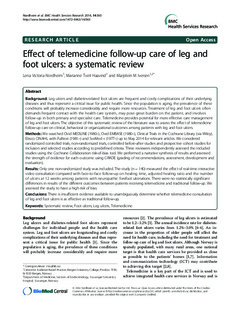| dc.description.abstract | Background Leg ulcers and diabetes-related foot ulcers are frequent and costly complications of their underlying diseases and thus represent a critical issue for public health. Since the population is aging, the prevalence of these conditions will probably increase considerably and require more resources. Treatment of leg and foot ulcers often demands frequent contact with the health care system, may pose great burden on the patient, and involves follow-up in both primary and specialist care. Telemedicine provides potential for more effective care management of leg and foot ulcers. The objective of this systematic review of the literature was to assess the effect of telemedicine follow-up care on clinical, behavioral or organizational outcomes among patients with leg and foot ulcers. Methods We searched Ovid MEDLINE (1980¿), Ovid EMBASE (1980¿), Clinical Trials in the Cochrane Library (via Wiley), Ebsco CINAHL with Fulltext (1981¿) and SveMed?+?(1977¿) up to May 2014 for relevant articles. We considered randomized controlled trials, non-randomized trials, controlled before-after studies and prospective cohort studies for inclusion and selected studies according to predefined criteria. Three reviewers independently assessed the included studies using the Cochrane Collaboration risk-of-bias tool. We performed a narrative synthesis of results and assessed the strength of evidence for each outcome using GRADE (grading of recommendations, assessment, development and evaluation). Results Only one non-randomized study was included. The study (n = 140) measured the effect of real-time interactive video consultation compared with face-to-face follow-up on healing time, adjusted healing ratio and the number of ulcers at 12 weeks among patients with neuropathic forefoot ulcerations. There were no statistically significant differences in results of the different outcomes between patients receiving telemedicine and traditional follow-up. We assessed the study to have a high risk of bias. Conclusions There is insufficient evidence available to unambiguously determine whether telemedicine consultation of leg and foot ulcers is as effective as traditional follow-up. | en_GB |

